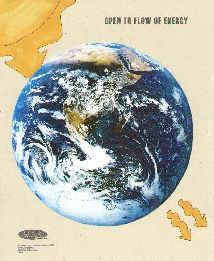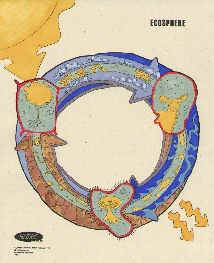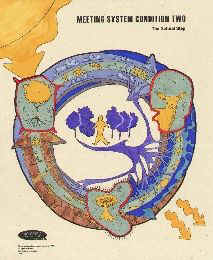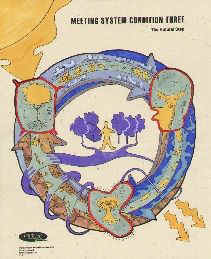

Criteria
for Sustainability
By Joanne
Tippett of Holocene Design
Sustainability lies in the interplay of environmental quality, economic vitality and social equity. Sustainable development can be defined as: ‘a dynamic process which enables all people to realize their potential and to improve their quality of life in ways which simultaneously protect and enhance the Earth’s life support systems’. (Forum for the Future). It is a process of moving towards sustainability. It can also be described as 'securing quality of life within the limits of nature' (Mathis Wakernagel).
In order to increase the quality of dialogue about sustainable development, it is helpful to decide on a clear set of criteria, which can be used as a basis for decision making and education. A clear mental model, focussing on agreed - upon principles, enhances communication as well as opportunities for creativity in planning how to achieve sustainable development.
These criteria act as a platform for communication, policy and strategic planning. The Natural Step (TNS) 1 model provides a framework for such criteria, based on consensus derived scientific principles and a systems approach to sustainability. The basic idea behind these criteria is to determine what is sustainable about the eco-cycle, then to ask what is it that we are doing as a society which is unsustainable. To know how to be sustainable, we must first understand what is unsustainable, conditions which cannot be breached in the long term. These criteria for un-sustainability can be derived from asking the question - what is it that we are doing which has no precedent in ecological history? From this, we can determine what behaviors do have precedent in ecological history, and use these as the basis for decision making and creative design of ways to increase quality of life. Holocene coined the term SUNstainability in 1998 because the term Sustainability is often used without reference to ecology and the vitality of the biosphere. SUNstainable implies the capacity to continue within the sun-driven cycle of ecology, without which there would be no economy or society. This capacity for continuance is a dynamic process that requires the global economy to work within the earth's life-support systems.
SUNstainability criteria :
| Balance of flows (system condition 1 of The Natural Step - TNS) | |
| Cycling of matter (system condition 2 of TNS) | |
| Ecosystem integrity (system condition 3 of TNS) | |
| Social system integrity (system condition 4 of TNS) |
"It is only
by understanding how the biophysical world works, that we can understand how
we need to operate
our human systems so that they do not breach the limits set by the biophysical
world." (Opportunities for Change,
A response by Forum for the Future to the consultation paper on a revised UK
strategy for sustainable
development, May 1998). The Natural Step Model provides such an understanding.
Read this article for more
detail on the consensus based science behind TNS.

| The Earth is a closed loop with regards to matter, but is open to a constant flow of energy. The matter on the Earth's surface may be rearranged, but the total of matter on Earth is constant (exceptions being the conversion of matter to energy in nuclear reactions, falling to Earth and the loss of some matter to space in the form of rockets, satellites and space ships). There is a constant flow-through of energy from the sun. |  |
Over millions of years, living organisms have interacted with the earth's surface to create a greater degree of concentration of matter and structure, which provide ecosystem service flows, in the form of fresh water supplies, soil maintenance and building, an atmosphere rich in oxygen, climate regulation, and maintenance of complex ecosystems and biodiversity. |
|
 |
Cycling
of matter (
system condition 2 )
In order for a society to be sustainable, nature's functions and diversity are not systematically subject to increasing concentrations of substances extracted from the Earth's crust. (© TNS)
|
 |
Ecosystem
integrity (
system condition 3 )
In order for a society to be sustainable, nature's functions and diversity are not systematically impoverished by overharvesting or other forms of ecosystem manipulation. (©TNS)
|
 |
Social
system integrity (
system condition 4 )
In order for a society to be sustainable, resources are used efficiently and fairly in order to meet basic human needs worldwide. (© TNS)
Humans have a right to opportunities to meet their needs. If human needs are not met, there will be unsustainable behavior. Needs should be met as a system, where the meeting of human needs in one area does not diminish the capacity to meet human needs in another area. This system condition can be illuminated by an understanding of Paul Ekin's 2 work on sustainable economics. There are ultimately only two sources of wealth: materials from the earth and human's skills and creativity. Economy is the management of resources in order to meet human needs, and is thus ultimately linked to both human's capacity for creativity and the biosphere. Former Senator Gaylord Nelson said it this way, "The economy is a wholly owned subsidiary of the environment. All economic activity is dependent upon that environment with it's underlying resource base. When the environment is finally forced to file under Chapter 11 because it's resource base has been polluted, degraded, dissipated, irretrievably compromised, then, the economy goes down into bankruptcy with it because the economy is just a subset within the ecological system." "From an economic perspective, concerns about sustainability are captured by the concept of ‘capital’, especially as distinct from ‘income’. Capital comes in many forms: Ecological capital comprises stocks and flows of energy and matter, and the physical states, such as climatic conditions or ecosystem characteristics, to which they give rise. Human capital comprises the abilities of individual people to do productive work and therefore includes physical and mental health, strength, stamina, knowledge, skills, motivation and a constructive and co-operative attitude. Social/organisational capital comprises the social structures and institutions which enable individuals to maintain and develop their human capital and be productive, and includes firms, trade unions, families, communities, voluntary organisations, legal/political systems, educational institutions, the health service, other social institutions (e.g. the welfare state), financial institutions and systems of property rights. Manufactured capital comprises material goods - tools, machines, buildings, infrastructure - which contribute to the production process but do not become embodied in the output." 2 Equity for future generations requires that our economic activity not degrade the capital upon which economic activity depends. Global equity requires that the process of economic activity in one part of the world does NOT degrade the capital (ecological, human, social or manufactured) in ANY other part of the world. Economic systems should not be set up in such a way that there is an inherent tendency for the interest of economic capital to accrue in some sector of society and not to reward all players in some way (unfair trade policies etc). "Diversity of culture: Diverse cultural traditions and activities consistent with sustainability are respected and practiced, as are peaceful relationships between communities." (Forum for the Future). Such diversity maintains possibilities and opportunities for economic vitality and strengthening of the social fabric. all images © 1998 Joanne Tippett and Buddy Williams |
References
1. The Natural Step, www.naturalstep.org return to text
2. Paul Ekin's work
on sustainable economics, quoted from Opportunities for Change, A response by
Forum for the Future to the consultation paper on a revised UK strategy for
sustainable development, May 1998
return to text
Copyright Joanne Tippett 1998, conceptual and editorial assistance from Gayle Hudgens, Matt Tippett, Buddy Williams
home